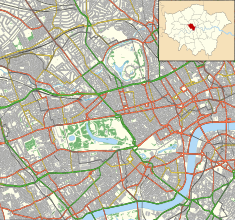| Westminster City Hall | |
|---|---|
 Westminster City Hall Westminster City Hall | |
| Location | 64 Victoria Street, Westminster |
| Coordinates | 51°29′51″N 0°08′15″W / 51.4976°N 0.1374°W / 51.4976; -0.1374 |
| Built | 1965 |
| Architect | Burnet Tait & Partners |
| Architectural style(s) | Modern style |
 | |
Westminster City Hall is a municipal building in Victoria Street in Westminster, London. It is the headquarters of Westminster City Council.
History
In the late 19th century the parishes of St Margaret and St John held their meetings at the old Westminster Town Hall in Caxton Street. However, after the enlarged Metropolitan Borough of Westminster was formed in 1900, civic leaders decided the Caxton Street building was inadequate for their needs, and decided to find larger facilities; they selected an existing building in Charing Cross Road, which re-opened as "Westminster City Hall" on 29 May 1902.
In the early 1960s, in anticipation of the impending further enlargement of the council's area, civic leaders again decided they needed larger facilities; the site they selected formed part of a larger development by Land Securities on a site previously occupied by Prince's Mansions in Victoria Street. The proposed development was a 76.20 metres (250.0 ft) high, 20-storey glass tower, designed by Burnet Tait & Partners in the modern style, which was built by Taylor Woodrow Construction. The enlarged City of Westminster was formed in March 1965, shortly before the completion of the new town hall in April 1965.
Initially, Westminster City Council only used the 20th floor, but gradually expanded to take the whole building. The principal rooms were the Mayor's parlour on the 19th floor and the committee rooms on the 18th floor, which were used for cabinet meetings as well as committee meetings.
The building was stripped back to a concrete shell during an extensive refurbishment between 2017 and 2019.
Notes
- Prince's Mansions was a large block of apartments, of a type known locally as "mansion flats", designed by Enoch Basset Keeling and completed in 1882.
References
- "Caxton Hall - foundation stone". London Remembers. Retrieved 16 May 2020.
- "London Government Act 1899". Butterworth and Co. 1899. Retrieved 16 May 2020.
- ^ "London's Town Halls". Historic England. p. 207. Retrieved 16 May 2020.
- ^ Hibbert, Christopher; Weinreb, Ben; Keay, Julia; Keay, John (2008). The London Encyclopaedia. Macmillan. p. 149. ISBN 978-1405049245.
- "Ordnance Survey Map". 1952. Retrieved 16 May 2020.
- "Victoria Street, Mansion Flats And Model Dwellings". University College London. 16 May 2018. Retrieved 16 May 2020.
- Curl, James Stevens; Sambrook, John (1999). "E. Bassett Keeling — a Postscript". Architectural History. 42. University of Cambridge: 307–315. doi:10.2307/1568716. JSTOR 1568716. S2CID 194990719. Retrieved 16 May 2020.
- "Westminster City Hall". Emporis. Archived from the original on 2 September 2019. Retrieved 16 May 2020.
- "Westminster City Hall". Open House London. Retrieved 16 May 2020.
- "Local Government Act 1963". Legislation.gov.uk. Retrieved 25 April 2020.
- "Health & Wellbeing Board". Westminster City Council. 3 July 2019. Retrieved 16 May 2020.
- "Cabinet". Westminster City Council. 10 February 2020. Retrieved 16 May 2020.
- "Plans for Westminster's City Hall to undergo refurbishment to drag it into 21st Century". My London News. 14 June 2016. Retrieved 16 May 2020.
- "Westminster City Hall". Buildington. Retrieved 16 May 2020.